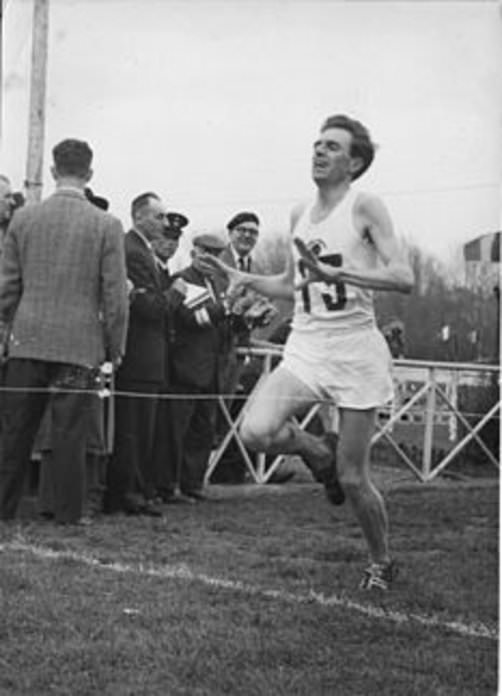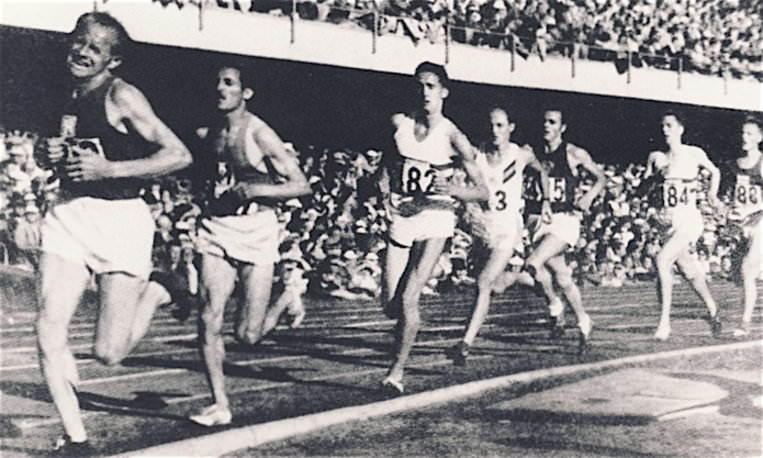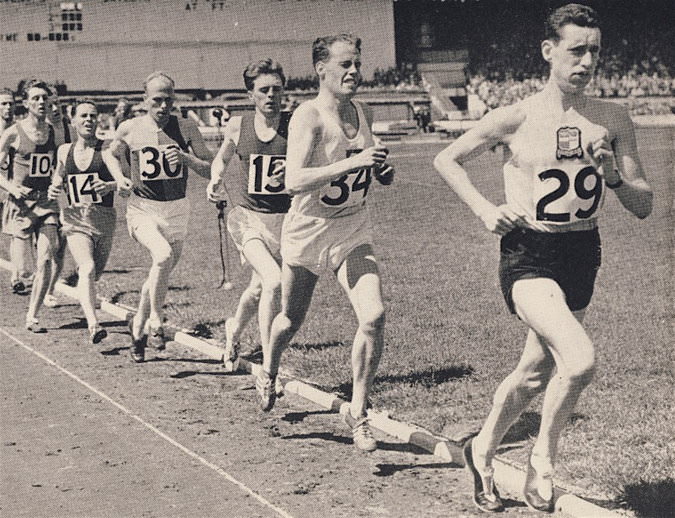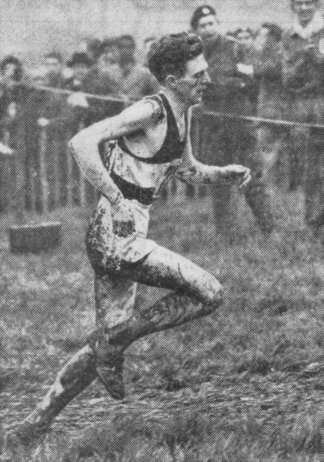Profile: Frank Sando
1931-2012
 |
In the 1950s Frank Sando was the premier cross-country runner in the world. No other runner came close to his record in the International Cross-Country Championships (the forerunner of the World Championships). Between 1952 and 1960, this English runner from Kent finished six times in the top three, winning twice. On the three occasions he wasn’t on the podium, he was ninth, fourth and eighth. But this remarkable and consistent record is not the full story of Frank Sando’s running career, for he was also successful on the track with two Empire medals and one European. Furthermore, he had a fifth place finish in the 1952 Olympic 10,000 final. And it is worth remembering that he was able to run at world level for nine years while holding down a full-time office job.
Many of those who saw Sando run have remarked on his light-footed running style. Of slight build (1.77m and 54 kg) he seemed to float over the ground “as if running on air” (words first used to describe Jack Lovelock’s running style). This ability was a great advantage in cross-country. As fellow runner Mick Firth said, “Imperceptibly he would drift over muddy ground.” (Alastair Aitken, The Winning Edge, p. 1.) Sando himself found his running style was an advantage. “When it came to mud, I seemed to get over it better than average,” he admits modestly.
Early Career
Sando discovered his talent for running when still at school. He joined Maidstone Harriers at 16 and was soon excelling. In 1948 and 1949 he finished fourth in the National Youth Cross-Country Championships. Then he started his national military service. He served at a training camp (No. 3 Btn, RASC, Farnborough, Hants) that had one of the best teams in the army, so he had plenty of time to train and even some competition. By the time he was demobbed at the end of 1951, he had matured into a much faster runner.
The next year saw his debut on to the international scene. After three fine cross-country runs (7th in the Inter-Counties, 5th in the National and 9th in the International), he showed form on the track as well. A big breakthrough came with a 13:48.0 Three Miles at the White City, where he finished second behind Gordon Pirie. In this race Pirie shattered the British record by 8.8 seconds; Sando was 5.6 under the record. He followed this fine Six-Miles run in 29:05.2, which qualified him for the British Olympic team—an achievement that had not seemed possible at the start of the year.
Olympic 10,000
 |
| Sando (84) runs with only one shoe in the 1952 Olympic 10,000 final. Zatopek, Mimoun and Pirie are the front three. |
At the Helsinki Olympics, Sando lined up with team-mates Pirie and Fred Norris in the 10,000. Before the end of the first lap, he lost his left shoe. But this didn’t stop him continuing “one shoe off and one shoe on,” as the old song goes: “Having got there, I wasn’t going to drop out,” he explains. While Pirie blew up after trying to win the race, Sando ran steadily and managed, to the surprise of many, to get fifth place, after a big battle with Posti of Finland, who beat him by just 0.4 of a second for fourth place. So Sando had run 9,700 meters on a cinder track with just one shoe, had finished only 3.6 seconds out of a bronze medal and had broken the British 10,000 record with a time of 29:51.8. It was an amazing end to an amazing first senior season.
Surprisingly the 21-year-old Sando now looked to another sport—grass hockey. He wanted to play a team game. So that winter he helped start the Aylesford Paper Mills Hockey Club and began to play the game while not giving up running completely. Fortunately for his running career, he wasn’t very good at hockey, and he was soon back to serious running.
Cross-Country Success
For the next seven years, the now international-level runner planned each year in the same way. The aim was to peak for the International Cross-country Championships. His whole cross-country season was used as preparation for this March race: “My plan was to come through for the International. The way I looked at it was….you had the county championship, which was fairly comfortable (I was pushed a couple of times). Then you had the Southern where you weighed yourself up. Then came the National, where you had to be in the first six to be sure of selection. After that there were no more big races until the International, where you did your best.” This strategy produced the amazing results in the International race over the next seven cross-country seasons.
The track was also part of his yearly plan, but it was definitely of secondary importance: “Cross country was my first love. The track just fitted in.” In other words, he used his high level of cross-country fitness to be competitive on the track. Despite this low-key approach, he had several very successful track seasons.
Frank Sando had a breakthrough season over the country in 1953. He was able to finish second in three major races: the Inter-Counties, the National and the International. And he took this form to the track, pushing Pirie to the limit in the British Games Three Miles, the Times calling this race a “glorious duel.” He ran against Pirie again in the AAA Six Miles. Pirie won in a new WR of 28:19.4 with Sando finishing second in 28:47.2, which was inside the British Record. He continued to run well into September winning an international 10,000 against Germany.
Major Meets in 1954
 |
| Sando (15) follows Driver and Ibbotson in a White City race. Foord, O'Gorman and Perkins follow. |
Track became a little more important in 1954 with both the Empire and European Games on his fixture list. Nevertheless, Sando ran well over the country with 2nd in the Southern, 3rd in the National and 4th in the International. On the track he improved his Six Miles time twice with 28:38.8 to win in the British Games and then 28:38.2 for second behind Peter Driver in the AAAs. His form earned him a place on the English team for the Empire Games in both the Three and the Six Miles.
He continued to show good form in the Vancouver Empire Games, where he placed a very close second behind Driver in the Six Miles. But this performance did not satisfy him: “It was disappointing,” he says. “I didn’t often go out to win, but I did for this race. The lap scoring was all wrong: we came round and it said ‘3’ to go but when we came round again it said ‘1.’ By then it was too late to make my effort as Peter Driver had much better miling speed.” Despite this, Sando gave Driver a great race on the last lap, finishing only 0.6 of a second behind (29:09.4 to 29:10.0).
In the Three Miles he was third with 13:37.4. Again he had a great battle on the last lap, this time with Freddie Green for second place behind Chataway. Green beat him by only 0.2 of a second for the silver. “Again I was slightly disappointed,” Sando admits.
After two Empire Games medals, he went on to the Europeans. There he ran an even better race in the 10,000, improving his PB by a huge margin with 29:27.6 and winning a bronze medal behind Zatopek and Kovacs. “That made up for not winning in the Empire Games,” he says. “In fact Peter Driver was quite a bit behind me this time.” Sando also beat the great German runner Schade into fourth place.
International Cross-Country Champion
Despite these track successes, Sando still focused on cross-country. And 1955 saw his first of two wins in the International. However, his season didn’t start well: “I was struggling,” he admitted. “I think I won the Kent County just, from Tony Weeks-Pearson. Then I ran in the Intercounties in the wrong shoes and finished 81st. I was still going backwards at the end.” Following improved runs in the Southern and the National (7th and 6th), Sando led the English team to victory in Spain. “It had been extremely cold that winter in England, but when we got to Spain, it was warmer, which made a lot of difference.” He was 150m behind the leaders after 3,000 but then moved through to take the lead at 6,000. Team-mate Hugh Foord followed him home for a 1-2 for England.
His good form again carried over to the track with PBs for Three Miles and Six Miles: 13:29.8 and 28:31. As well, he ran several international races for his country, winning with Ken Norris against Germany and getting a 2nd and a 3rd against France and Czechoslovakia. These successes on the track boded well for the Olympics at the end of the following year.
After an ankle injury and the flu in the winter, Sando returned to fitness only for the big 1956 cross-country races, finishing 5th in the Nationals and then tying for 2nd —“not contrived,” he was anxious to point out--with Ken Norris in the International. The track season saw two PBs for Six Miles. He won the Inter-Counties in 28:24 and ran 28:14.2 for 2nd behind Norris in the AAAs. Then came three consecutive international wins against Czechoslovakia, Germany and Hungary.
 |
| Sando, covered with the mud of Parliament Hill, wins the 1957 English Cross-Country title. |
Second Olympics
Sando’s hopes for the Olympics later that year were high. But for once, he did not run well in a big race, finishing 10th in the Olympic 10,000, nearly a minute behind winner Vladimir Kuts. “It was probably my biggest disappointment, because I was running extremely well,” he recalls. “I had found a lot of finishing speed. I went out to Australia early and trained with Gordon Pirie. I just didn’t have it on the day.”
Return to Cross-Country
Understandably, Sando’s 1957 cross-country season started slowly: he had arrived home from Australia in December, jetlagged and disappointed. It wasn’t until the Southern that he started to show form, placing 6th despite some shoe problems. Then he won the National by 17 seconds from Driver and Norris. “That was one of my best races,” he says. “I had them all in my sight and just picked them off as I wanted to.” It was his only victory in this prestigious race. Now in top form, Sando went on to win the International for the second time. He achieved this win “with consummate ease,” according to The Times. “It wasn’t that easy,” Sando admits with a chuckle.
After a virtually non-existent 1957 track season--he was taking exams--Sando showed almost as good form over the country in 1958, finishing 3rd, 2nd and 3rd in the Southern, National and International. An ankle injury from a fall put paid to any performances on the track that year, but he was ready again for the big 1959 cross-country races, coming second to Eldon in the Southern, second to Fred Norris in the Nationals and second to Fred Norris again in the International. He ran only a few track races that summer, most notable a Six-Miles clocking of 28:49.4 in the Inter-counties.
At this time, the 27-year-old Sando started night classes to earn academic qualifications in statistics: “That took up a lot of my time. I was training at midnight.” On minimal mileage he nevertheless still had a reasonable 1960 cross-country season with 5th in the Southern, 9th in the National and 8th in the International. But he came to realize that he could no longer train enough to stay at the top level. In May 1960, he announced his retirement from top-class competition.
Conclusion
Sando was unusual for a top-class distance runner in that he was not primarily driven to beat his opponents. “I liked winning,” he explains, “but running well was more important.” So he often raced to place well or to run to his satisfaction. His annual focus was always the International Cross-country Championships. It is a testament to the intelligence and discipline of this self-coached runner that he was able to peak so successfully for that race year after year. His competitive record is all the more impressive because he held down a full-time job throughout his running career and thus had to limit his weekly training load to only 45 miles (72K). Looking back on his career, he had this succinct comment: “I enjoyed it.” So it’s no surprise that at 80, this great distance runner is still involved in the sport--as secretary of the Kent CAA Cross Country Sub-committee. 
10 Comments